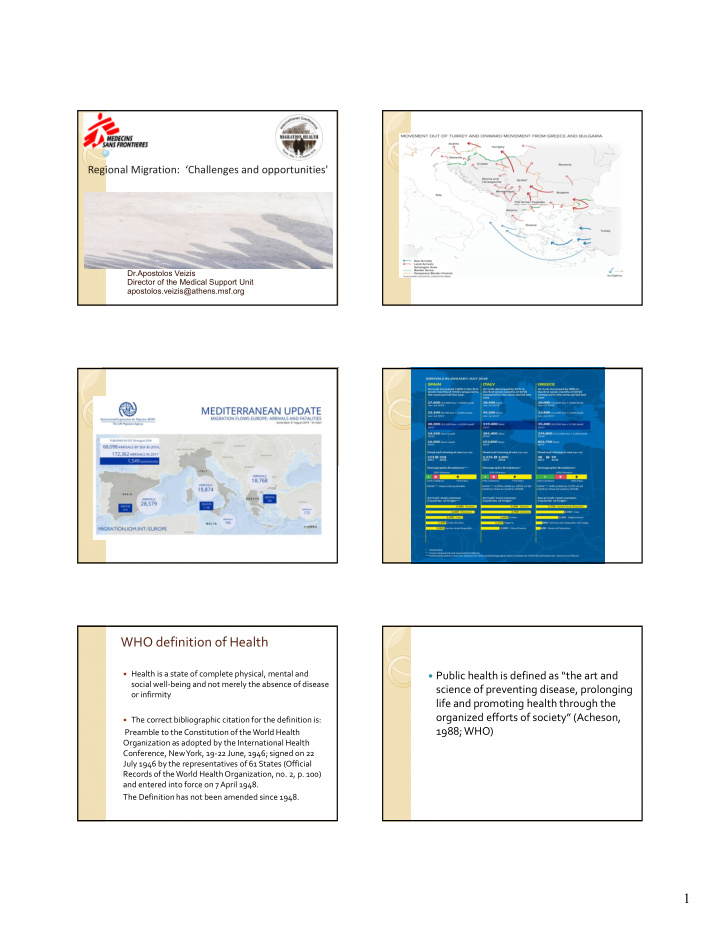



Regional Migration: ‘Challenges and opportunities' Dr.Apostolos Veizis Director of the Medical Support Unit apostolos.veizis@athens.msf.org WHO definition of Health Health is a state of complete physical, mental and Public health is defined as “the art and social well ‐ being and not merely the absence of disease science of preventing disease, prolonging or infirmity life and promoting health through the organized efforts of society” (Acheson, The correct bibliographic citation for the definition is: 1988; WHO) Preamble to the Constitution of the World Health Organization as adopted by the International Health Conference, New York, 19 ‐ 22 June, 1946; signed on 22 July 1946 by the representatives of 61 States (Official Records of the World Health Organization, no. 2, p. 100) and entered into force on 7 April 1948. The Definition has not been amended since 1948. 1
Life, health and human dignity at risk Mixed migration routes to the EU : orchestrated humanitarian crisis When one is closed another one opens… More and more refugee profiles More and more women and children Violence and loss of human dignity People pushed ‐ back and stranded People dying on the way Dignity, safety, and respect for the basic rights that The needs… all people have are enshrined in international humanitarian, human rights and refugee law... Restrictive policies Consequences • Detention as deterrence Lack/discrimination in access to health care • Poor reception conditions Violence and violations of (as deterrence?) human rights Torture and ill ‐ treatment • Externalization of border Interruption of chronic controls/containment treatment • Closure of borders MH disorders Correlation between sub ‐ • Active forced/voluntary standard living conditions & return policy diseases Labor exploitation and human • Push ‐ backs trafficking • Readmission agreements 2
Migration to EU:5 persistent challenges and ECDC field visit report, 2011 fundamental right concerns “The main problem is the increased risk for communicable diseases in the detention 1. Strict border management centers, mainly linked to severe overcrowding, lack of hygiene, lack of basic supplies (e.g. 2. Inadequate living conditions in reception blankets, shoes, soap, etc.), lack of the centres possibility for outdoor activities and the long duration of detention . The conditions in the 3. Restrictive asylum procedures centers are below the internationally accepted minimum standards in all visited detention 4. Leaving unaccompanied children vulnerable centers. It is well documented that overcrowding 5. Immigration detention increases the risk for communicable diseases spread, such as tuberculosis, diarrhea, upper respiratory infections, etc” European Center for Disease Control, 2011 . ‘Games Of Violence – Unaccompanied Children And Young People Repeatedly Abused By EU Member State Border Authorities’ The report is based on information of young men or boys aged between 15 and 25 injured while attempting to cross towards the Schengen Zone treated by MSF in its primary and mental health care clinic in Belgrade in the period from January to June 2017. 69% (86) of MSF’s patients under 18 reported of direct violence, the majority had visible physical injuries. 76% named state authorities as perpetrators, of which majority (92%) were EU border forces. The young patients reported about mistreatment in camps, detention centres, at police stations in Bulgaria, Croatia or Hungary. 3
Challenges Multiple actors: Coordination ‐ collaboration Cultural mediation: ◦ Many languages @MSF/Anna Surinyach ◦ Not enough Patients on the move /stranded ◦ Quality care ◦ Follow ‐ up – continuity of care @MSF/Jodi Hilton Increased vulnerability Multiple traumatic life ‐ events Physical & Mental health needs – chronic diseases Transit population: difficult to follow ‐ up – continuity of care @MSF @MSF/Alessandro Penso @MSF/Achilleas Zavallis @MSF/Florian Lems This report shows that providing regular preventive care, as opposed to providing only emergency care, is cost ‐ saving for healthcare systems. Even when using a simple model to estimate costs, the implications are clear: treating a condition only when it becomes an emergency not only endangers the health of a patient, but also results in a greater economic burden to healthcare systems The hypertension model was also applied to other time periods. When the costs were calculated for a period of five years and then over a lifetime, the cost ‐ savings of providing regular access to care over emergency treatment increased. Over a period of five years, the cost ‐ savings increased between 12 % and 13 %. The cost ‐ savings over a lifetime were even higher, about 16 % 4
• EU Charter of Fundamental Rights Human dignity is inviolable. It must be respected and protected New areas and locations: Recommendations At transit and destination countries in EUROPE: Authorities need to assume their humanitarian and legal responsibility & take action: Safety – living conditions – early vulnerability screening Free, easy access to healthcare (physical/MH care) ◦ Preventive (screening, perinatal, vaccinations) ◦ Curative (acute/chronic) ◦ Cultural mediation Innovative ways for continuity of care & follow ‐ up @MSF Research priorities Analysis of the data of the medical structures/NGOs/actors on arrival Analysis of the data of the medical structures/NGOs/actors in transit Analysis of the data of the medical structures/NGOs/actors final destination Why no medical services/resources provided proactively by the authorities VS police/military resources 5
6
Recommend
More recommend